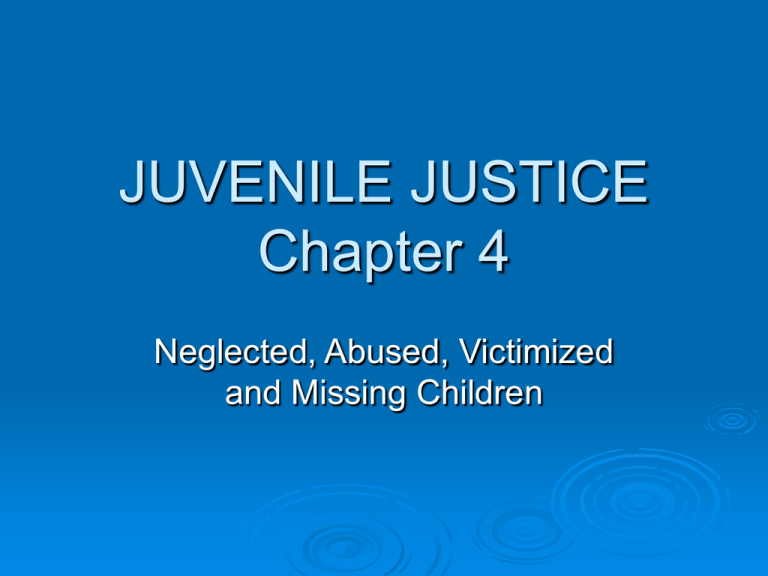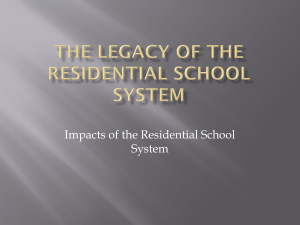
JUVENILE JUSTICE
Chapter 4
Neglected, Abused, Victimized
and Missing Children
Maltreatment of Children
Maltreatment:
Increased risk of poor academic performance
Displaying symptoms of mental illness
Girls are at higher risk of:
Neglect
Medical Neglect
Physical Abuse
Sexual Abuse
Psychological Maltreatment
Teen pregnancy
Drug Use
Engaging in serious and violent delinquent acts
1/12 Violent crime victims is below the age of 12
Maltreatment of Children
Research found that there is a strong
relationship between child maltreatment and
adult criminality and violent behavior
Violent or sexual victimization of children often
lead to intergenerational cycle of violence and
abuse
3 million referrals regarding 5 million children
were made to CPS agencies in 2001
903,000 children found to be maltreated
1,300 children died as a result of abuse or neglect
Review 4.1 Defining child maltreatment and its
severity on Page 108
Neglected Children
Neglect
is defined as
Inattention to basic needs, including the lack
of supervision, adequate clothing and proper
nutrition
Usually come from poor & disorganized
families that have death, divorce or desertion
of parents
No set routine for family activity
Children roam the streets at all hours
Continuous involvement in FC for loitering or
curfew violations
Neglected Children
Broken Homes deprived children of:
Affection
Recognition
Sense of belonging
Children may lose respect for ethical or moral
values
Develop aggressive attitudes
Parents spend very little time with children
Children may act-out to gain attention
Neglected Children
Physical
Indicators of Neglect
Frequent Hunger
Poor Hygiene
Inappropriate Dress
Consistent Lack of Supervision
Unattended Physical or Medical Needs
Abandonment
Neglected Children
Behavioral
Indicators of Neglect
Begging for or stealing food
Arriving too early or leaving late from school
Constant Fatigue
Listlessness or falling asleep in school
Alcohol and/or drug abuse
Delinquency
Stealing
Reporting that no one is home to care for
them
Physically or Emotionally Abused Children
Historical Roots of Abuse
Infants killed as a form of birth control
Retarded or deformed children killed
Ancient Greece: Father has absolute power over child
Ancient Roman: Father has power of life or death
over children. He could kill, mutilate, sell or offer as
sacrifice
Industrial Revolution: Children worked as many as 16
hours a day with leg irons to keep them from running
away
Parents permitted to beat children as a way of
discipline
Extreme physical punishment seen as necessary
Physically or Emotionally Abused
Children
Child
Protection Service founded in 1875
Social Security Act in 1925 authorized
public funds for children
X-ray technology allows doctors to detect
patterns of abuse in children in the 1940’s
1964 states begin to enact mandatory
child abuse laws
1966 all 50 states have mandatory child
abuse laws
Physically or Emotionally Abused
Children
Child
abuse and neglect laws have 3
components:
Criminal definitions and penalties
A Mandate to report suspected cases
Civil process to remove child from abusive
and/or neglectful environment
Federal Laws: Parents have a right to use
physical punishment as long as it is
reasonable
State Laws: What is reasonable varies from
state to state, from judge to judge and jury to
jury
Physically or Emotionally Abused
Children
Causes
of Abuse
Generational
Other characteristics include low income,
social isolation, parental expectations
Two leading causes include Domestic
Violence & Poverty
Seesaw Model:
• Functional Family: Resources and Stressors
Balanced
• Nonfunctional Family: Unbalanced Resources and
Stressors. Stressors tend to be overwhelming
Physically or Emotionally Abused
Children
American
Medical Association identified
children at risk for abuse
Premature birth
Birth of child to adolescent parents
Colic
Congenital defects or abnormalities
Hospitalization of infant due to lack of parental
contact
Condition that interferes with parent-child
bonding
Physically or Emotionally Abused
Children
Physical
Indicators of Physical Abuse
Unexplained Bruises, Burns, Fractures,
Lacerations and Abrations
Behavioral
Indicators of Physical Abuse
Wary of Adults
Apprehension when other children cry
Extreme aggressive or extreme withdrawal
Frighten of parents
Afraid to go home
Physically or Emotionally Abused
Children
Physical Indicators of Emotional Abuse
Speech Disorders
Lags in physical development
General failure to thrive
Behavioral Indicators of Emotional Abuse
Sucking
Biting
Rocking Back and Forth
Antisocial or Destructive Behavior
Others include sleep disorders, inhibitions in play,
obsessions, compulsions, hypochondria, attempted
suicide
Physically or Emotionally Abused
Children
Child Abuse is the biggest single cause of child
death, which is usually caused by parent or
caretaker
Maximalist Alarmist Perspective
Earlier generations were reluctant to recognize that
child abuse was escalating and must face the facts
that child abuse is occurring in record numbers
Minimalist Skeptical Perspective:
Large numbers of abuse cases are mistaken
allegations mixed with true allegations which makes
the appearance of child abuse seem bigger than it
actually is.
Physically or Emotionally Abused
Children
THREE LEVELS ABUSE
Collective Abuse
Seen in poverty and other forms of social injustice
Ex. Millions of children live in poverty: not enough
food, dirty drinking water, live in rat infested or lead
exposed housing
Violence on TV
Pornography
Illegal child labor
Hazardous working conditions
Physically or Emotionally Abused
Children
Institutional Abuse
Occurs in institutions that allow physical force
or violence against children in institutions
such as schools, detention centers, training
schools
Individual Abuse
Physical or sexual abuse by one or more
people, usually parents, other family members
or individuals
CHILD ABUSE AND
DELINQUENCY
Child Abuse is directly linked with delinquency
Delinquent children are usually imitating
behaviors of parents or other family members
Some children are taught by family members to
commit crimes
Strong relationship between abuse and
delinquent behaviors
Early childhood maltreatment showed little effect on
later delinquent behaviors
Early childhood, early adolescent and a late
adolescent maltreatment were linked to both
delinquent and drug using behaviors
Sexually Harassed or Abused
Children
Happens
often in school, as early as
elementary
4/5 (81%) students experienced some
type of sexual harassment in school
Each year over 100,000 cases of child sex
abuse is reported.
HOWEVER, it is reported than 90% of
sexual abuse is not reported
Sexually Harassed or Abused
Children
Classification
of Sex Abuse
Intrafamilial Sexual Abuse is abuse by
parent(s) or other family member
Extrafamilial Sexual Abuse is is abuse by
friend or stranger
Sex abuse by babysitters small (4.2%) but
occurr twice as much as physical abuse
Sex Abuse by Catholic Clergy
Sexually Harassed or Abused
Children
PHYSICAL INDICATORS OF SEX ABUSE
Venereal disease (HIV/AIDS/STDS)
Pregnancy
BEHAVIORAL INDICATORS OF SEX ABUSE
Unwillingness to change clothes
Withdrawn
Fantasy or infantile behavior
Bizarre sexual behaviors
Sexual sophistication beyond one’s age
Poor peer relations
Delinquent Behaviors
Runaway Behavior
Reports of being sexually abused
Sexually Harassed or Abused
Children
Consequences of Sexual Abuse
Guilt
Shame
Delinquent Behavior
Depression
Anger Low Self Esteem
Need to please others
High Absenteeism
Lower Grades
Low participation in activities
Becomes a dependent of the Family Court
SEXUAL ABUSE AND THE
INTERNET
In a study of 1,501 youths, ages 10 -17
1/5 Children receive a sexual solicitation over
the internet
1/4 children had unwanted exposure to naked
people or people having sex over the internet
3 % received aggressive solicitation involving
offline contact or attempts for contact
1998 Federal Child protection and Sexual
Predator Punishment Act imposes tough
penalties to persons who commit sex crimes
against children, especially those who use the
internet
CULTURAL VALUES AND SEXUAL
ABUSE
Cultural
Values Play a role in determining
what constitutes sexual abuse.
Some accepted as normal in one culture, but
considered as sex abuse in another
Female Circumcision or Female Genital
Mutilation (FGM) is considered a rite of
passage in some African countries
16,000 U.S. immigrants have submitted to
FGM
Polygamy involving teenage girls
CREDIBILITY OF SEXUAL ABUSE
Divorce
Issues regarding allegations of
sexual abuse
Making a child lie about sexual abuse is
abuse
Although rare, false allegations do occur
(14%)
CHILDREN AND YOUTHS AS VICTIMS OF
CRIMES AND VIOLENCE
Youth ages 12 – 17 have been victims
of property crimes
African American juveniles are overrepresented
Youth are twice as like to be victimized
than those over age 25
Majority of youth that were assaulted
tended to engage in risky behaviors, and
delinquent and/or aggressive acts
1/6
CHILDREN AND YOUTHS AS VICTIMS OF
CRIMES AND VIOLENCE
Victims were prone to:
Engage in illicit activities that caused
conflict
Associate with delinquent friends who had
poor social or problem-solving skills
Victimized other delinquents
Had little recourse to legal means of
conflict resolution
WITNESSING VIOLENCE
Delinquency is related not only to experienced
victimization, but to:
Vicarious strain which refers to real-life strains
experienced by others around the individual
Anticipated Strain, which refers to the individual’s
expectation that current strains will continue into the
future or that new strains will be experienced
There is a strong relationship between youth exposed
to violence through direct victimization, witnessing
violence and association with delinquent peers
WITNESSING VIOLENCE
There is a link between victimization and
avoidance as a coping strategy
Domestic violence found to exist in 20-40% of
families of chronically violent adolescents
Child abuse present in 30-70% of families where
there is spouse abuse
30-60% overlap between violence between
children and violence against women in the
same families.
Children who witness domestic violence
experince higher levels of behavioral, social and
emotional problems.
WITNESSING VIOLENCE
Violence
is learned behavior that is selfperpetuating
Adults teach youth that those who are
bigger and stronger may force their wishes
upon others who are smaller
Missing and Exploited Children
National
Incidence Studies of Missing,
Abducted, Runaway and Throwaway
Children in America (NISMART) defines a
missing child in two ways:
Those missing from their caretakers
(caretaker missing) 1,315,600
Those missing from their caretakers and
reported to an agency for help to locate them
(reported missing) 797,500
Missing and Exploited Children
Runaway/Throwaway:
Occurs when child leaves home without permission
and stays away overnight
Child 14 years old or younger chooses not to return
home when told to and stays away overnight
Child 15 years or older chooses to stay away more
than two nights
Usually children who cannot cope with relationship in
family
Many are depressed, insecure, unhappy with low selfesteem
Typically report conflict with parents
Many become street wise
Missing and Exploited Children
Throwaway incident occurs when child is asked
or told to leave home by a parent or other
household adult
Non-family Abduction occurs when non-family
perpetrator takes a child by the use of physical
force or threat of bodily harm or detains a child
for an hour
Stereotypical Kidnapping occurs when a
stranger or slight acquaintance detains a child
without permission for overnight, transported 50
miles or more, held for ransom or killed.
Family Abduction occurs when a TRO or custody
order is in place.
Missing and Exploited Children
SIX PROFILES OF PARENTS AT RISK FOR
ABDUCTING THEIR CHILDREN:
Prior threat or actual abduction
Parent suspects or believe abuse has occurred and
friends and family members support these concerns
Parent is paranoid or delusional
Parent is a severe sociopath
Parent is from another country in a mixed cultural
marriage
Parent feels alienated from legal system and have
family support in another community
Missing and Exploited Children
Department of Health and Human Services
through its Administration for Children, Youth
and Families (ACYF) and the Justice
Department through its Office of Juvenile Justice
and Delinquency Prevention (OJJDP) have
concurrent jurisdiction for missing and exploited
children
ACYF focuses on social welfare, emergency care of
missing children
OJJDP focuses on the challenges that missing
children present to law enforcement and JJS.
YOUTHS AND SUICIDE
Signs and symptoms of suicide include:
Irritability or anger;
Continuous feelings of hopelessness or sadness;
Social withdrawal;
Increased sensitivity to rejection;
Changes in appetite (either increased or decreased)
Sleeplessness or Excessive sleep
Vocal Outburst or crying
Physical complaints
Feelings of worthlessness or guilt
Impaired thinking
Thoughts of Suicide
YOUTHS AND SUICIDE
Suicide
is the second leading cause of
death among teens with 500,000 attempts
and 5,000 completions
Warning Signs include:
Threats to kill one’s self
Preparing for death
Giving away favorite possessions
Writing good-bye ‘
Talking as if no one cares









